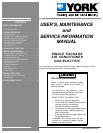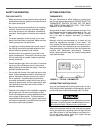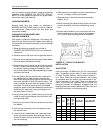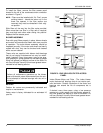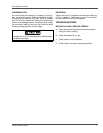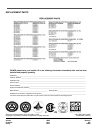
035-18843-000-A-0402
4 UnitaryProductsGroup
If the furnace continues to lock out, a qualified service
technician should be called to determine the cause of
the problem.
EXPLAIN UNIT FUNCTION
When the system is functioning properly, show the
owner the location of all disconnect switches and the
thermostat. Explain how to start and stop the unit and
how to adjust temperature settings within the limitations
of the system. Advise that the flue exhaust hood sur-
face and the immediate area will experience high tem-
peratures during the heating cycle, and that all
unauthorized personnel and debris must be kept away
from this area.
GENERAL MAINTENANCE
In order to insure long and trouble free service from
your system, we recommend periodic inspection,
cleaning, lubrication and adjustment by your installing
Dealer/Contractor. Be sure to ask about this service.
For those who prefer to do-it-yourself, please follow the
instructions listed below to care for your system.
Snow or debris should not be allowed to accumulate in
or around the unit. Do not permit overhanging struc-
tures or shrubs to obstruct outdoor air discharge, com-
bustion air inlets or vent outlets on your unit. These
provide air for combustion and ventilation. Adequate air
is important to the safe and proper operation of the
unit.
HEATING SYSTEM INSPECTION
It is the owner's responsibility to insure that an annual
inspection of the entire heating portion of the unit is
made by a qualified service technician. This should
include inspection of the burner, heating element and
flue for any corrosion or soot accumulation which may
require cleaning and also checking of burner and con-
trols for proper operation.
In addition, at least once during the heating season,
the owner shall make a visual inspection of the flue out-
let for evidence of black soot or blockage of flue outlet
by leaves or other debris. If any soot is found, it is rec-
ommended a qualified service technician be called
immediately. If any blockage is found, it must be
cleared immediately.
Check for obvious signs of deterioration of the unit.
Check that the return and supply ducts attached to the
unit are sound and air tight. Check that the unit's physi-
cal support, concrete slab or roof curb, is sound and
not in need of repair. Make sure there are no gaps
between the roof curb and the unit where rain could
leak into the building.
Start the furnace. The vent motor should start, the
igniter will start to spark and ignite the pilot flame. After
a short delay the main burner should ignite. If it does
not, contact a qualified service technician for assis-
tance. Check the appearance of the main burner flame.
Adjust burner shutters so no yellow flame is observed
in the heat exchanger tubes. (See Figure 3.) If flame
adjustment cannot be made, obtain the assistance of a
qualified service technician and refer to the PILOT
CHECKOUT and BURNER AIR SHUTTER ADJUST-
MENT sections in the UNIT INSTALLATION INSTRUC-
TION.
BURNER AND PILOT CHECK
Periodically (at least annually at the beginning of each
heating season) make a visual check of the pilot and
main burner flame. If necessary, adjust main burner pri-
ELECTRICAL SHOCK, FIRE OR EXPLOSION HAZARD
Failure to follow safety warnings exactly could result
in dangerous operation, serious injury, death or prop-
erty damage.
Improper servicing could result in dangerous opera-
tion, serious injury, death or property damage.
• Before servicing, disconnect all electrical power
to furnace.
• When servicing controls, label all wires prior to
disconnecting. Reconnect wires correctly.
• Verify proper operation after servicing.
PRIOR TO ANY OF THE FOLLOWING MAINTE-
NANCE PROCEDURES, SHUT OFF ALL POWER
TO THE UNIT, TO AVOID PERSONAL INJURY.
FIGURE 3: TYPICAL FLAME APPEARANCE



